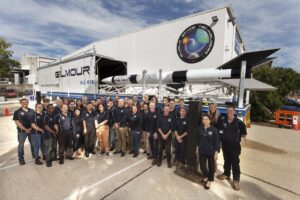UK Space Ambitions: 100 year wait until Sutherland spaceport sees a return?
18th Sep 2019
It feels as if we are at a crucial point in the UK’s space ambitions with a lease agreement in place for the proposed Sutherland spaceport and the detailed plans apparently ready for public display with a consultation process scheduled prior to actual planning permission being sought.
A number of entities have already committed funding to the project and much of this has gone into the design stage and likely the drawing up of lease agreements as well as the pre-planning reports that were released fairly recently.
In a more southerly part of the country, we have other organizations committed to providing launch facilities in Cornwall, including Richard Branson’s Virgin Orbit. Although, these launch facilities will operate as a horizontal launch with the use of modified Boeing 747s. A similar project is also on the cards at Prestwick Airport in Ayrshire. Both of those projects are quite different from the three vertical launch sites proposed at different locations across Scotland.
The Sutherland spaceport isn’t the only one in the running, as a few other locations have been bidding for their share of what is potentially a £4bn business. One such site in North Uist recently had over 500 objections to their planning permission applications, following a coordinated campaign by those against the project for environmental reasons.
Another location being proposed for launching small satellites into orbit is at Unst, located in the Shetland Isles. The Shetland Space Centre project is in its very early stages, but appears to have had significant pledges of support since coming onto the scene.
Out of all the proposed sites, the Sutherland location has had the most backing from the government-funded UK Space Agency with grants being awarded to US company Lockheed Martin and Orbex Space, a company mostly operating out of Denmark.
A closer examination of the plans set out initially for Sutherland suggested that 20 launches per year would be scheduled for that particular site. Although the recent announcement outlining the public consultation process has suggested a maximum of 10 launches per year. Other reports have suggested six launches per year.
Whether it is 6, 10 or 20 launches from the Sutherland Spaceport, it is looking likely to take quite some time before either the UK Space Agency or the consortium’s investors see any return on their investments. With initial expenditure looking highly likely to exceed the £100m mark and potentially anywhere between £25m and £100m on additional infrastructure including roads, bridges & utility services, at a conservative estimate of £1m revenue per launch, a twelve-year period of operation would generate £120m in gross revenue and with the extremely high costs of launching rockets this may only generate £12m in profit. This would then give you a ‘break-eve’ point around 100 years down the line.
Funding
To date, the UK Space Agency have awarded £23.5m to Lockheed Martin. Highlands and Islands Enterprise have pledged £9.8m to the project. Orbex Space have been awarded £5.5m by UKSA and have announced a total of £30m in inbound private investment. £5m will be put into the venture by the Nuclear Decommissioning Authority. The UK government have pitched in £2.5m in grants. This gives us a total of £46.3m already pumped into the spaceport alone, by the local and central government.
Highlands and Islands have recently announced that they are nervous about being the largest investor in the project and are seriously concerned at the high risk involved with costs set to soar. They have been talking about approaching the Scottish Government for some form of financial support.
One then has to ask whether it’s worth it at all. But there is more to it than profitability and there are government grants via the UK Space Agency that will keep the books of those companies looking healthy for quite some time. And, of course, the companies involved in the launch operations will need to spread themselves out to open up more launch opportunities by exploiting the newly found space ambitions of the Portuguese Azores, Norway & Sweden.
So, whilst the likes of Orbex Space can build their enterprise on the back of UK Space Agency grants, their actual profits may be found elsewhere. This then raises the question of where the UK will gain any actual benefits from its entry into the space business. The likeliness is that it will mostly benefit the country in terms of reducing its reliance on the facilities of other European countries for any future satellite requirements. And when all the proposed launch sites are in full operation there should be plenty of capacity for government agencies to then have full access to satellite launch facilities on their own doorstep. The MoD would most definitely have a need to place satellites into orbit, but also the departments responsible for Agriculture, Fisheries & the Environment would likely find benefit in having their own satellites.
The infrastructure of the future Scottish spaceports
The three Scottish sites that have put forward proposals for vertical launch pads all have very clear advantages and disadvantages. The advantages are mostly around their locations as they are cited as offering the very best routes to orbit. The disadvantages are mostly around their locations as by the very nature of the Scottish Highlands they are in places that aren’t so easily accessible by road. And whilst those locations are difficult enough to reach by car, the challenge for the types of vehicles delivering large volumes of fuel and the materials required for building a launch pad become somewhat of a nightmare. So, there will need to be some quite significant infrastructure changes to accommodate this.
The route to the Sutherland Spaceport takes you over the Invernaver Bridge spanning the River Naver. The bridge itself is too narrow for a heavy goods vehicle and results in a sharp turn at the end, so it is looking increasingly likely that a new bridge and connecting roads will need to be constructed just to accommodate the traffic to and from the Sutherland location. And in this sort of rugged, hilly landscape, this will be no simple task. But it is an unavoidable one.
The transportation of concrete alone to the launch pad site as well as the removal of excavated dirt will see the movement of large construction vehicles to and from the site for up to 2 years and then afterwards will likely see daily deliveries of fuel, so it is crucial that the roads are up to the job for the project to take off initially and then to ensure long term viability.
The same, of course, will apply to the other two proposed Scottish launch sites, which present their own challenges. The most obvious of which is that there is a body of water en route to both of the island locations. But those islands will generally be quite familiar with transporting heavy loads from the mainland via ferry, as well as fuel tankers. So, the real challenges will be down to the specific launch locations and any hurdles in the way of reaching them. There are no specific details of any plans or proposals for the other two Scottish sites yet and no UK Space Agency funding has been announced, so it is difficult to fully evaluate them at this stage.
Another of the proposed UK launch sites is located at Newquay Airport in Cornwall. As it is already a fully operational airport there is unlikely to be any significant infrastructure requirements and any investment will be taken up mostly by the construction of on-site facilities. This facility will mostly be operated by Virgin Orbit who will launch rockets horizontally from modified Boeing 747s.
Richard Branson’s company have secured some funding for their Cornwall project, from both the local council and the UK Space Agency, although this has brought with it some controversy and objections from locals and some councillors who have proposed that the money would be better spent tackling climate change in line with the council’s recent declaration of a climate emergency.
There are also signs that another horizontal launch facility will emerge at Prestwick Airport, which is owned and operated by the Scottish Government. This has been proposed as a very ambitious project with a 10,000 sq ft aerospace and innovation centre being built with £80m in funding, of which £32m has been pledged by the UK government, £30m from the Scottish government and £18m from South Ayrshire Council.
So, whilst the Sutherland Spaceport appears to have made the most significant progress it also appears to have the most obstacles in front of it and the Prestwick site seems to have the most widespread support across its local council, the Scottish government and the UK government.
We will not assume that any apparent silence from all other sites means that nothing is happening. It would be fair to assert that many conversations will be taking place and progress being made across the board. In fact, it is often the case that those making the most noise are making the least progress but have to keep investors and stakeholders happy so push out the occasional press release. They may simply have the largest PR budget.
Timeline
The timing of the UK’s space ambitions are likely to change, but as things stand the following milestones are what has been announced so far:
- September 18 – Cornwall Council Cabinet supported £12m funding for Spaceport Cornwall by a margin of 6 votes to 4
- October 4 – Beginning of public consultation process for Sutherland spaceport
- October 14 – State Opening of Parliament and Queen’s Speech – Prime Minister Boris Johnson has suggested the space bill could be included
- November 25 – Final public consultation event for proposed Sutherland spaceport
- November 26 – Cornwall Council’s full council meeting to approve Spaceport Cornwall funding
- Late 2019 – groundwork starts at Spaceport Cornwall
- Early 2020 – Space Industry Act passed
- Early 2021 – spaceflight regulations in place with UK Space Agency and Government
- Early 2021 – applications accepted for a spaceport licence
- Mid 2021 – range licence, spaceport licence and operator licence granted
- September 2021 – first commercial “pathfinder” launch by Virgin Orbit planned from Spaceport Cornwall
We will keep a very close eye on all developments across the UK and will watch with interest for the first major milestones to be met and at the very least the breaking of ground somewhere, anywhere.






Thank you for your comment! It will be visible on the site after moderation.